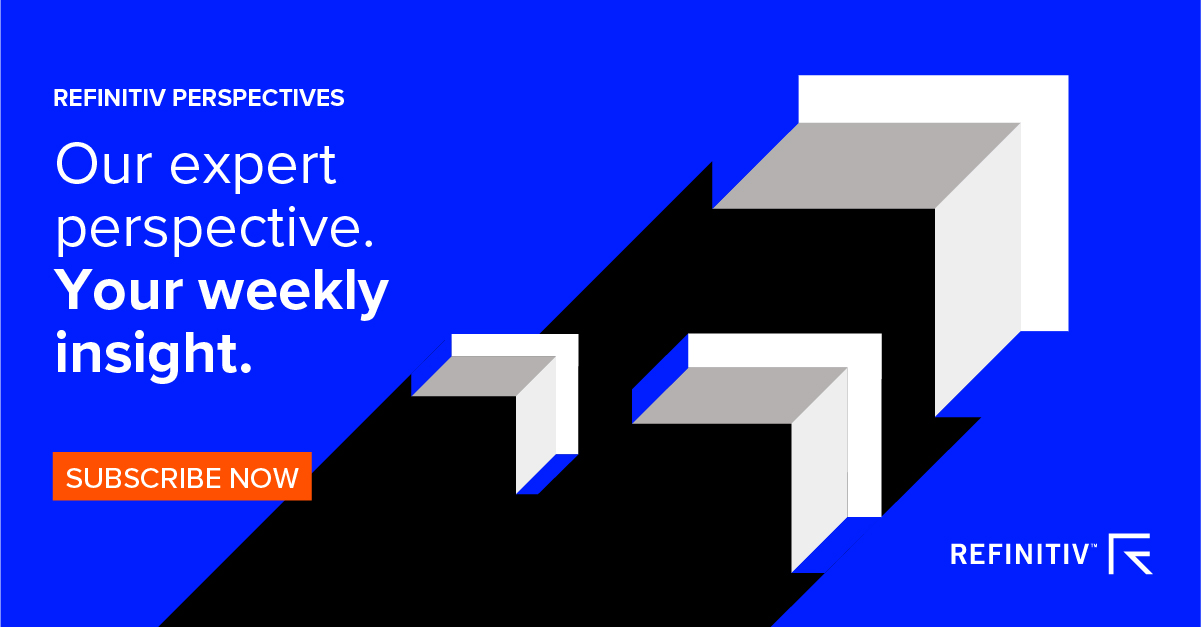Major central banks have set a deadline of the end of 2021 for investors to switch from LIBOR to alternative benchmarks. Alexandre Hardouin analyzes the differences between the Secured Overnight Funding Rate (SOFR), the proposed alternative, and LIBOR in September’s Market Voice.
- With the move into a post-LIBOR market fast approaching, the transition towards new benchmarks will be a complex undertaking.
- The Secured Overnight Funding Rate (SOFR) is the proposed alternative for USD LIBOR. However, there are differences between the two benchmarks. For example, SOFR is much more sensitive to day-to-day market movements than LIBOR.
- Eikon has created screens that are dedicated to providing real-time information on the evolving LIBOR replacement benchmarks in all major financial markets.
For more data-driven insights in your Inbox, subscribe to the Refinitiv Perspectives weekly newsletter.
The end of LIBOR (London Inter-Bank Offer Rate) is fast approaching.
The major central banks have set the end of next year as a deadline for investors to switch from LIBOR to alternative benchmarks, and there is risk that a forced transition could come sooner.
There are currently around 15 banks regularly reporting rates daily to the Intercontinental Exchange Benchmark Administration (IBA), which is responsible for posting the daily fixing. However, the number of reporting banks has been declining, and if it drops below four, the IBA will not be able to post the LIBOR fixings.
Across global markets, there are over $200 trillion in securities that have some link to a LIBOR rate, so even if LIBOR’s timeline stretches to the end of 2021, there is potential for significant market disruptions as the transition occurs.
Watch: How can clients use Eikon to solve the LIBOR challenge?
Alternative benchmarks to LIBOR
Developed country central banks are designating alternatives to serve as benchmarks ahead of the retirement of LIBOR.
The proposed alternative for USD LIBOR is the Secured Overnight Funding Rate (SOFR), the median of rates that market participants pay to borrow cash on an overnight basis, using Treasuries as collateral.
Unfortunately, there are significant differences between LIBOR and SOFR, so it is not a simple benchmark replacement. As indicated, SOFR is an overnight rate and so does not directly align with the multiple maturities available for LIBOR fixes.
Switching benchmarks will require compounding the SOFR to an equivalent maturity for the LIBOR being replaced. And the collateralization of SOFR based rates makes it a riskless benchmark, unlike LIBOR, which is for uncollateralized borrowing with credit risk — again, an adjustment will be required to align the benchmarks.
Figure 1: SOFR vs Overnight LIBOR One-Month Volatility

Aside from the technical differences, there is an important procedural difference between the methodology of calculation.
SOFR is a straightforward average of market rates whereas the IBA is empowered to use “judgement” in generating the benchmark fixing from the contributed bank rates. SOFR is much more sensitive to day-to-day market movements than LIBOR. The distortions from maturity and credit risk are minimized by comparing SOFR with the overnight LIBOR rate.
As shown in Figure 1, even with this limited comparison, the stronger market link makes SOFR volatility substantially higher than LIBOR — and the volatility-of-volatility is also much higher.
Why is SOFR so prone to spikes?
Figure 2 shows the daily closes for SOFR and Overnight LIBOR, and again, the noisier nature of SOFR is apparent. But notably, SOFR regularly makes 25 to 50 basis point spikes that are not matched by LIBOR. In September, SOFR spiked over 200 basis points.
While SOFR is technically considered a “risk-free” rate, it appears to introduce risk as a replacement benchmark for legacy LIBOR-linked contracts.
Much of the noise is predictably calendar related, with SOFR spikes commonly occurring at the end of each quarter. Hikes in the Fed funds rate (shown in Figure 2) also seem to be a reliable source of SOFR spikes.
Figure 2: Most Attractive Emerging Market vs USD 1Y Rate Spread

There is no definitive explanation for the outsized SOFR spike that occurred in mid-September 2019, which is disturbing because this represents a substantial risk factor in benchmarking legacy LIBOR contracts.
The spike is not close enough to the end of September to fit in with the standard quarter-end pattern and the rise in Fed funds was coincident rather than preceding the spike. The spike was probably a by-product of unusual monetary conditions: The Federal Reserve has shrunk its balance sheet to reverse their earlier policy of quantitative easing and it bottomed in September at its lowest level since 2013.
Money market stress is also apparent in the 10-year swap vs Treasury spread going negative during this period (Treasuries as the risk-free rate normally are lower than the swap rate). In more recent months, the Fed has returned to aggressive balance sheet expansion to offset the negative economic impact of COVID-19.
As is apparent in Figure 2, SOFR has become much more stable since the Fed opened the monetary faucets. As long as the Fed remains in expansion mode, the slippage between SOFR and LIBOR should be modest, but there remains clear risk that SOFR volatility will return when the Fed finally starts pulling back on the monetary reins.
Figure 3: Monetary Conditions and the Big Spike in SOFR

Difficulties in switching to new benchmarks
The dawn of the post-LIBOR market is on the horizon, and shifting to new benchmarks is far from a trivial task.
Eikon has created a series of screens (shortcut: IBOR) dedicated to providing real-time information on the evolving LIBOR replacement benchmarks in all major financial markets.
Technical adjustments will be required to align the risk-free overnight SOFR rate to the mixed matured and credit sensitive LIBOR rates. And SOFR should remain closely linked to LIBOR as long as the Fed is expanding liquidity. However, SOFR probably will ultimately be a more volatile benchmark than LIBOR.
Read our report, developed in collaboration with Waters Technology: Moving forward with LIBOR transition and IBOR reform.






